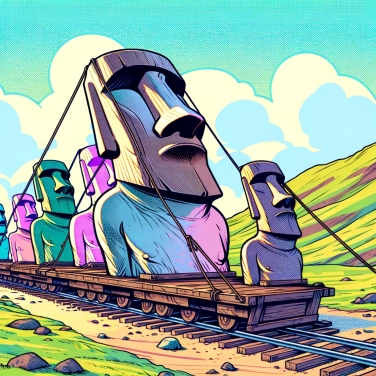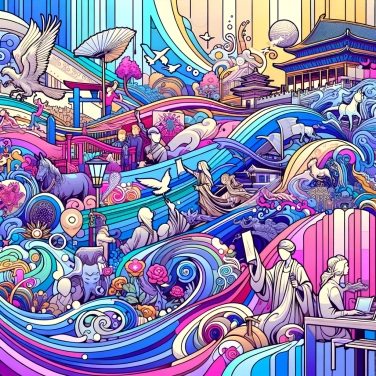In detail, for those interested!
Why were the statues on Easter Island moved?
The statues of Easter Island, known as moai, were moved for various reasons. The main motivations behind this massive displacement lay in the religious and political beliefs of the island's inhabitants. The moai were considered representations of deified ancestors and had to be placed on ahus, ceremonial platforms, to honor these ancestors and ensure the prosperity of the community. The movement of the statues was therefore linked to important religious rituals.
Furthermore, the transport of the moai also illustrates the power and prestige of the different tribes of Easter Island. Moving a monumental statue over long distances was an impressive technical and logistical feat that demonstrated the strength and competence of local chiefs. This strengthened their legitimacy and authority within the community.
Finally, the statues were sometimes moved to mark important events or major social changes. For example, during internal conflicts or changes of power, the moai could be moved to reflect these transformations within Easter Island society.
In summary, the statues of Easter Island were moved for religious, political, and social reasons, which attests to the symbolic and cultural importance of these monuments for the island's population.
The techniques for moving the statues of Easter Island
The techniques for moving the statues of Easter Island were mainly based on the use of ropes, levers, and rhythmic movements. The statues of Easter Island, called moai, were carved from volcanic rock and often weighed several tons. To move them over sometimes significant distances, the islanders used sophisticated techniques.
A common method involved tilting the statue onto wooden logs to gradually tip it over and move it short distances. For longer distances, the islanders used ropes to slowly advance the statues by rocking them from side to side. This technique, called "swinging," allowed them to transport the moai over long distances without needing to carry additional loads.
Stone levers were also used to lift the statues and move them forward gradually. By constantly adjusting the position of the levers, the inhabitants of Easter Island were able to precisely direct the moai in the desired direction. These ingenious techniques allowed the statues to be moved over kilometers through sometimes difficult terrain, demonstrating the ingenuity and technical mastery of the ancient inhabitants of Easter Island.
The reasons behind the displacement of statues over long distances
The reasons behind the movement of statues over long distances are rooted in several key elements. Firstly, the inhabitants of Easter Island, due to their religious beliefs, considered the statues, called moai, as living representations of their ancestors. Thus, moving them was a sacred act meant to honor and communicate with the spirits of the deceased.
Furthermore, the movement of the statues was also motivated by political and social considerations. The different tribes on the island were vying for control of resources and the prestige associated with the moai. Moving a monumental statue over a long distance was a way to demonstrate the power and superiority of one tribe over another.
Additionally, the inhabitants of Easter Island used sophisticated techniques to move the moai, such as using logs as wheels to facilitate transport over kilometers. This expertise demonstrates the ingenuity and organization of this island civilization.
Finally, moving the statues over long distances could also be linked to practical considerations, such as seeking better environmental conditions for the moai, such as more visible sites or locations more conducive to religious ceremonies.
By combining these various elements, one can understand that the reasons behind the movement of statues over long distances were complex and multipolar, blending religious, political, social, and practical aspects within Easter Island society.
The consequences of the displacement of the statues of Easter Island
The displacement of statues on Easter Island had significant consequences on the island's environment. The massive movements of the moai led to deforestation on the island, as trees were cut down to facilitate the transport of the statues over long distances. This deforestation resulted in a decrease in local biodiversity, as well as soil erosion in the absence of roots to hold it in place.
Furthermore, the displacement of the statues impacted the island's water resources. Deforestation caused a decrease in freshwater sources, essential for the survival of the island's inhabitants. The consequences of these actions on the environment were long-lasting, and Easter Island experienced irreversible changes due to the transport of the moai over long distances.
In addition to the environmental consequences, the displacement of the statues also had social repercussions on the population of Easter Island. The efforts required to move the moai mobilized a large part of the population, likely leading to tensions and internal conflicts. Moreover, the resources used for these displacements could have negatively impacted other aspects of the inhabitants' lives, such as agriculture or fishing.
In summary, the displacement of statues on Easter Island had significant environmental and social consequences, which significantly altered the ecosystem and the lives of the island's inhabitants.
![Explain why some countries change time zones?]()
![Explain why Alexander the Great refused to wear shoes.]()
![Explain why Alexander the Great always wore an impressive helmet.]()
![Explain why the last Chinese emperor was so young when he came to power?]()





















